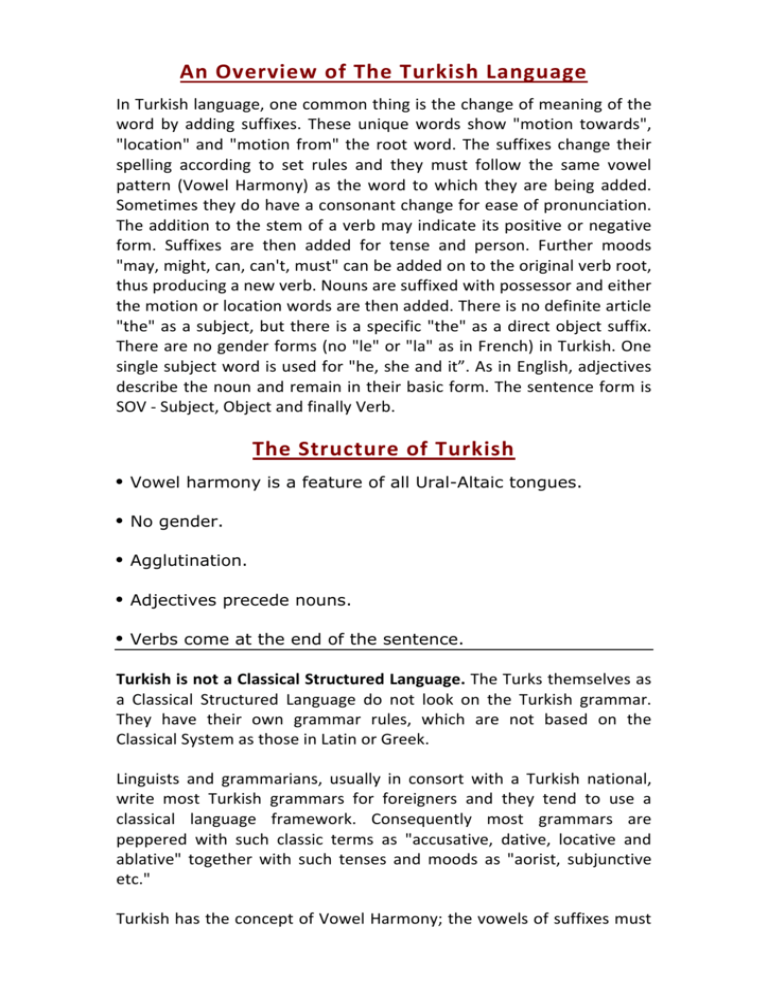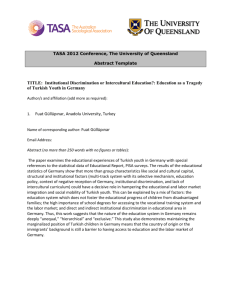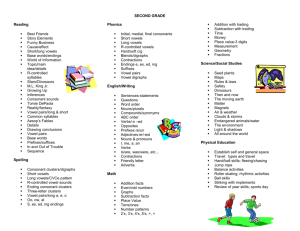about Turkish Language
advertisement

An Overview of The Turkish Language In Turkish language, one common thing is the change of meaning of the word by adding suffixes. These unique words show "motion towards", "location" and "motion from" the root word. The suffixes change their spelling according to set rules and they must follow the same vowel pattern (Vowel Harmony) as the word to which they are being added. Sometimes they do have a consonant change for ease of pronunciation. The addition to the stem of a verb may indicate its positive or negative form. Suffixes are then added for tense and person. Further moods "may, might, can, can't, must" can be added on to the original verb root, thus producing a new verb. Nouns are suffixed with possessor and either the motion or location words are then added. There is no definite article "the" as a subject, but there is a specific "the" as a direct object suffix. There are no gender forms (no "le" or "la" as in French) in Turkish. One single subject word is used for "he, she and it”. As in English, adjectives describe the noun and remain in their basic form. The sentence form is SOV -­‐ Subject, Object and finally Verb. The Structure of Turkish • Vowel harmony is a feature of all Ural-Altaic tongues. • No gender. • Agglutination. • Adjectives precede nouns. • Verbs come at the end of the sentence. Turkish is not a Classical Structured Language. The Turks themselves as a Classical Structured Language do not look on the Turkish grammar. They have their own grammar rules, which are not based on the Classical System as those in Latin or Greek. Linguists and grammarians, usually in consort with a Turkish national, write most Turkish grammars for foreigners and they tend to use a classical language framework. Consequently most grammars are peppered with such classic terms as "accusative, dative, locative and ablative" together with such tenses and moods as "aorist, subjunctive etc." Turkish has the concept of Vowel Harmony; the vowels of suffixes must mirror the final vowel of the root word being suffixed. Also "Consonant Mutation" where spelling changes are made to preserve phonetic euphony with actual pronunciation. English has some consonant change but not for the same reasons. There is also a "Reflexive Genitive" in Turkish where both the "owner" and "owned" are suffixed. This construction does not occur in classical grammar so many teachers have resorted to using a Persian name "izafet". The ACDC follows Turkish Grammar nomenclature, calling it the "Possessive Relationship". Turkish is characterized by vowel harmony, consonant mutation and agglutination (word suffixation). Postpositions are used instead of prepositions. Thus suffixes added to the stem of the verb may indicate positive or negative forms of the passive, reflexive, causative, potential, subjunctive moods plus further additions for tense and person. Nouns are also suffixed with possessor ("my, your") and condition ("to from, in"). Both the subject definite article and grammatical gender are lacking. Adjectives precede their noun and do not have to agree in number or case. The sentence form is SOV -­‐ Subject, Object and Verb. The Features of Turkish Grammar The Alphabet -­‐ Consists of twenty-­‐one consonants and eight vowels. The Adjectives -­‐ Adjectives and adjectival phrases precede their noun and do not agree in number. Vowel Harmony -­‐ Turkish has eight vowels, four pairs (A-­‐E, I-­‐İ, O-­‐Ö, U-­‐Ü) with corresponding front/back, and rounded/unrounded sounds, which form the basis for vowel harmony. According to vowel harmony rules, vowels of suffixes must have the same properties as the vowel in the last syllable: either front/back or rounded/unrounded. Agglutination [Affixed suffixes or suffix groups -­‐ words are composed of a sequence of word elements, each of representing only one grammatical category.] -­‐ Agglutination in Turkish takes the form of suffixes attached to the end of a word, whether noun or verb. Suffixes add to the word's meaning and/or mark its grammatical function. The Absence of Gender -­‐ Turkish does not have a definite article, nor does it have gender pronouns. A single word signifies he, she, it. Verbs -­‐ Always come at the end of the sentence. Sentence construction follows the subject-­‐object-­‐verb pattern. The Structure of Turkish -­‐ It differs in both grammatical structure and vocabulary from the Indo European Group, English, Spanish, French etc. It is also a phonetic language as each letter always retains its own sound. In English the sound of the letters can change, as the letter a does in fat, fate, fare etc. In Turkish there is no such pronunciation change to letters of the alphabet. Consonant Mutation -­‐ In certain circumstances changes are made to the spelling of consonants. If the pronunciation of a consonant changes the spelling also changes to reflect this. Vowel Harmony -­‐ A grammatical rule where subsequent vowels in a word or suffix follow the vowel properties (rounded/unrounded, front produced/back produced) of the previous vowel. Turkish Noun Conditions These six conditions are suffixed to the root word according to Vowel Harmony Rules. The vowels of the suffix match the final vowel of the root word. Title Condition (Nominative): The root word which carries no suffix. el -­‐ hand, the hand. Ownership Condition (Genitive): -­‐in/-­‐ın/-­‐un/-­‐ün This is the condition of "belonging to" meaning of, 's -­‐ in English -­‐ elin [el-­‐in] -­‐ the hand's, of the hand. Specific Object Condition (Accusative): -­‐i/-­‐ı/-­‐u/-­‐ü This is is the direct object of a verb meaning specific the in English -­‐ eli [el-­‐i] -­‐ the hand (obj.) Movement Towards Condition (Dative): -­‐a/-­‐e This is the condition of movement towards meaning to, towards in English -­‐ ele [el-­‐e] -­‐ to/towards the hand. Static Position Condition (Locative): -­‐da/-­‐de or -­‐ta/-­‐te according to Consonant Mutation rules. This is the condition of place and position meaning in, on, at in English -­‐ elde [el-­‐de] -­‐ in/on/at the hand. Movement Away Condition (Ablative): -­‐dan/-­‐den or -­‐tan/-­‐ten -­‐ according to Consonant Mutation rules. This is the condition of movement away meaning from, by, via in English -­‐ elden [el-­‐den] -­‐ from/by/via the hand. Turkish Grammar is Regular Turkish pronunciation is Phonetic. In Turkish, each letter of the alphabet always retains its basic pronunciation. Turkish grammar is regular but differs in that it consists of post-­‐positions, which are suffixed directly to nouns or other parts of speech to modify their meaning. This use of suffixes is called agglutination, literally meaning "a gluing on". This is in contrast to English, which uses individual prepositions for the same reasons. Another peculiarity of Turkish is the Vowel Harmony where vowels change in pronunciation and spelling to mirror the previous vowel in a word. Agglutination -­‐ (a sticking on to). The putting together of language particles where each expresses a single definite meaning, thus forming a new word. In English there are many words, which agglutinate (extend) to form other words. The word -­‐ argue can be agglutinated to argument by sticking on a -­‐ment suffix. This word can take additions of further suffixes: -­‐ative giving argumentative and even further to argumentatively by adding a -­‐ly suffix. The Turkish Way There is similar way of word extension in Turksih but even the minor words like prepositions in, from, at are suffixed to their noun, thus producing an extended word. An examples, adding the suffix -­‐de -­‐ in, on, at and the suffix -­‐dan – from ev – house evde -­‐ [ev-­‐de] -­‐ in the house. evden -­‐ [ev-­‐den] -­‐ from the house. These suffixes harmonize with the vowel in the word ev. Most suffixes follow the Rule of Vowel Harmony. There is both an A-­‐ UnDotted Vowel Form -­‐ A I O U, and an E-­‐Dotted Vowel Form -­‐ E İ Ö Ü for the same suffix. Similarly adding suffix -­‐da -­‐ in, on, at and -­‐dan -­‐ from oda -­‐ room odada -­‐ [oda-­‐da]-­‐ in the room odadan -­‐ [oda-­‐dan] -­‐ from the room These suffixes harmonize with the final vowel of the word oda. Consonant Mutation Changes in pronunciation and spelling of consonants to preserve phonetics and euphony. About Voicing of Consonants. A Voiced Consonant is one where the voice box is used to produce the sound -­‐ d, b -­‐ are in this category. An Unvoiced Consonant is where the voice is silent and only air is expelled to produce the sound such as t, p. The Main Consonants with Two Forms in Turkish. There is some consonant mutation in English. The terminal -­‐y of lady changes to an -­‐ie-­‐ in the plural -­‐ ladies, and the terminal -­‐f of knife changes to a -­‐v-­‐ in the plural -­‐ knives. Turkish has consonant change, but it is little more complex than English. The changes: k to ğ and d to t. The main changes that occur in Turkish words is that a terminal -­‐k may change to a -­‐ğ -­‐ (soft g) when a suffix with a vowel is added. The first letter -­‐d of a suffix may change to a -­‐t when the suffix is added to a word ending in a hard consonant ç,f,h,k,p,s,ş,t. There are also some other minor consonant changes. Turkish Vowels In Turkish, the voice sounds are separated into two main groups, consonants and vowels. When there is no obstacle to a voice then the sound is called a vowel. There are eight vowels in Turkish: a,e,ı,i,o,ö,u,ü. The Eight Vowels of Turkish. The eight vowels are divided into two groups, the Un-­‐Dotted Vowels and the Dotted vowels. The 4 Un-­‐dotted Vowels -­‐ a ı o u. The 4 Dotted Vowels -­‐ e i ö ü. Dotted vowels are pronounced at the front of the mouth (as the French Language) while their Un-­‐Dotted counterparts are pronounced at the back of the mouth (more like English). Vowel Classification. (A) According to the position of tongue and exit. Thick vowels: a, ı, o, u. Thin vowels: e, i, ö, ü. (B) According to the lips positioning. Straight vowels: a, e, ı, i. Rounded vowels: o, ö, u, ü. (C) According to the mouth opening. Wide Vowels: a, e, o, ö. Narrow vowels: ı, i, u, ü. Straight Wid Narrow e Thick a ı -­‐ (UnDotted) Thin e i -­‐ (Dotted) Vowel Harmony Basics. Rounded Wid Narrow e o u ö ü The E-­‐Dotted Group of four vowels are e, i, ö, ü. The A-­‐UnDotted Group of four vowels are a, ı, o, u.. The harmony lies in the fact that all Turkish words of Altaic Turkic Origin are pronounced either entirely containing A-­‐UnDotted Vowels, as kapılar -­‐ doors or bulmacaları -­‐ their crosswords, or entirely containing E-­‐Dotted Vowels, as evlerinden -­‐ from their house or köylüler -­‐ the villagers. Grammatical and verb suffixes also follow vowel harmony, being divided into two groups for front-­‐vowel words and back-­‐vowel words. For example, the Undotted -­‐ back-­‐vowel -­‐ plural suffix -­‐lar would be added to kapı to form the word for -­‐ doors -­‐ kapılar whereas the Dotted -­‐ front-­‐vowel -­‐ plural suffix -­‐ler would be added to köylü to produce -­‐ villagers -­‐ köylüler. Turkish has imported many words from French, such as televizyon -­‐ télévision and müzisyen -­‐ musician, kuaför -­‐ coiffure which have been modified phonetically to the Turkish Alphabet and incorporated into the language. These are spelled according to Turkish phonetics and often have both front and back vowels within one word which is unnatural for Turkish. Such is true for the numerous Turkish words of Arabic origin, such as mektup -­‐ letter and merhaba -­‐ hello, and of Persian origin as hane -­‐ office where vowel harmony does not occur in the word itself. In these cases, consistent with the general rule for vowel harmony in Turkish, the final vowel of the word determines the vowel harmony for suffixation. Vowel Harmony Reference Un-­‐Dotted Vowels follow each other. Dotted Vowels follow each other. Turkish Verbs There are no irregular verbs in Turkish. One single conjugation is used for all verbs. Turkish Verbs also obey vowel harmony rules. All verbs belong to one of two groups determined by their infinitive forms, those ending in -­‐mak [The A-­‐UnDotted Vowel Group] and those ending in -­‐ mek [The E-­‐Dotted Vowel Group]. The suffixes for all -­‐mak verbs have only A-­‐UnDotted Back Vowels bakmak -­‐ to look becomes bakacak -­‐ he will look.. However only E-­‐ Dotted Front Vowels are found in the suffixes of -­‐mek verbs gelmek -­‐ to come becomes gelecek -­‐ He will come. In consequence there is more than one form for the tense sign suffix and in this case the future suffix may be -­‐acak or -­‐ecek to follow Vowel Harmony Rules. Turkish Gender and Articles Turkish does not have a subject definite article "the", also there is no gender distinction, so there is no "le" and "la" problems as in French, Italian etc. This borne out by the fact that Turkish only has one word for -­‐ he, she and it, namely -­‐ o. Turkish makes a word definitive by adding an object suffix. This is the objective "the" in Turkish. This is one of the difficulties for those learning Turkish as English does not distinguish between subject "the" and object "the" as it uses the definite article "the" for both. An illustration of the Objective Definite Article (accusative):Fincan masada. -­‐ The cup is on the table. [subject: "The cup"]Masadaki fincanı bana verin. -­‐ Give me the cup which is on the table. -­‐ [object: The cup"] Here the object the cup -­‐ fincan has been made definitive (specific) by the addition of the objective suffix -­‐ı to produce fincanı, the way of saying the cup as an object. Turkish Adjectives Turkish is a descriptive language, adjectives abound and if Turkish can make something into an adjective then it will do so. Being a descriptive language basically, the adjective or adjectival phrases always precede its noun: kara kedi -­‐ a black cat as in English. However Turkish makes great use of adjectival phrases and clauses to describes nouns, actions and thoughts. In English we may say: The black cat with the long tail, which is sitting on the mat, looks hungry. Or using a Reduced Relative Clause we usually say in English -­‐ The black cat with the long tail sitting on the mat looks hungry. The Turkish way, however, will describe the cat not only as black but also where and upon what it is sitting together with any other attributes, such as its long tail: On the mat which-­‐is-­‐sitting long tailed black cat hungry looks. -­‐ Minderin üstünde oturan uzun kuyruklu kara kedi aç görünüyor. In Turkish the subject and object are described adjectivally with regards to place and disposition. Once all the describing is done, the verb is placed last in the sentence. Structure of Turkish Words The structure of Turkish words is vowel followed by a consonant which is then followed by a vowel or vice versa. A vowel always follows a consonant and a consonant always follows a vowel. There are no diphthongs (two vowels occurring together) in Turkish words, other than imported foreign exceptions. In order to preserve this rule certain consonants are inserted as "buffers" between vowels. These buffers are always Y, N or S. Y is considered as a consonant in Turkish. The majority of Turkish Vowels are always pronounced quite in low tone as there is no lengthening of vowels. For Turkish learners, this sometimes makes understanding the language difficult as there is very light stress in Turkish pronunciation. Turkish Word Order Word order is regular, but differs from English Adjectival Descriptions of Subject. Subject -­‐> Time Clauses -­‐> Adjectival Descriptions of Object -­‐> Object -­‐> Verb. The verb is always last in a sentence. Turkish punctuation normally puts a comma after the subject of a sentence. It is good practice to do this especially if the subject is extended by a long adjectival description. An English example: The man with the fishing rods in his hands, -­‐ a long described subject -­‐ will be at -­‐ the verb -­‐ your friend's 50th birthday party -­‐ a long described object -­‐ tomorrow night -­‐ time phrase. Let’s put that into Turkish Structure: Ellerinde oltası olan adam, yarın gece arkadaşının 50'ci doğum günü partisinde bulunacak. Hands-­‐his-­‐in fishing-­‐rod-­‐the which-­‐are man, -­‐ a described and suffixed subject -­‐ tomorrow night -­‐ time phrase-­‐ friend-­‐your-­‐of 50th birthday party-­‐his-­‐at -­‐ a described and suffixed object -­‐ will be -­‐ and at last, the verb. In learning Turkish you are setting out on a cultural, historical and linguistic adventure! Our top tips for learning Turkish are: • Take regular lessons with a good teacher • Set aside ten minutes each day to study a little Turkish using a study book or notes you have made • If you have Turkish friends in Hong Kong, practice speaking some Turkish with them. • If you can watch Turkish Movie or TV (We recommend "soap operas" where the storylines are simple and the context gives hints to what is being said). • When you have time practice reading. Children’s story books can provide a charming way of reading a fairly simple language. • Some Turkish newspapers have an online version. Try them out! • A link to a wide variety of Turkish Language newspapers is found at www.gazetelerweb.com/ • Do you know that the BBC offers Turkish language pages? www.bbc.co.uk/turkce/ •In learning language, It is always better to do a little but often rather than a lot in one go and then leave it for ages. • Above all have fun… if it seems tedious you probably wouldn’t be making most out of your language learning experience.







